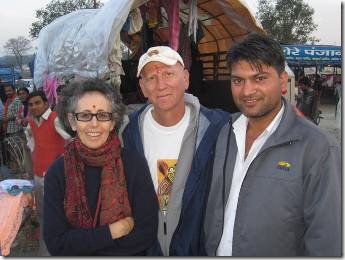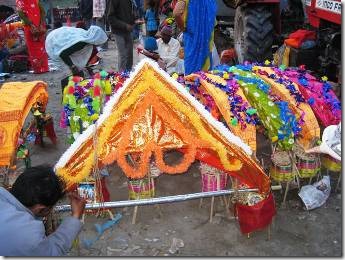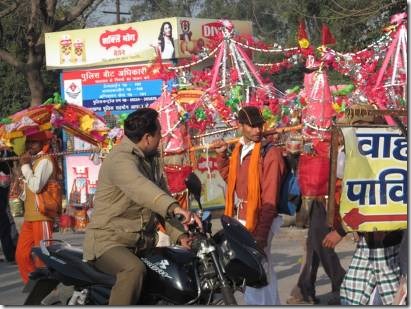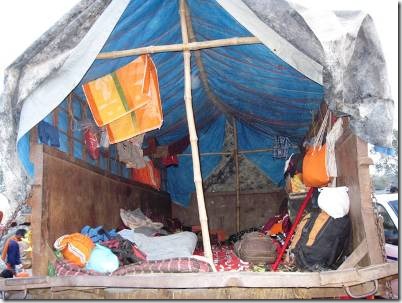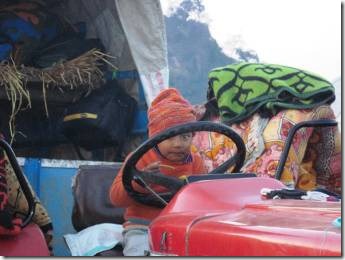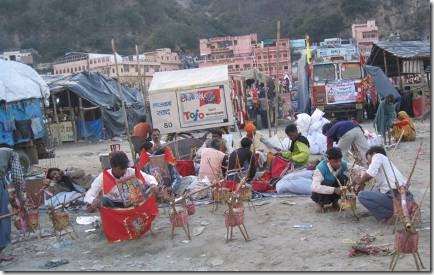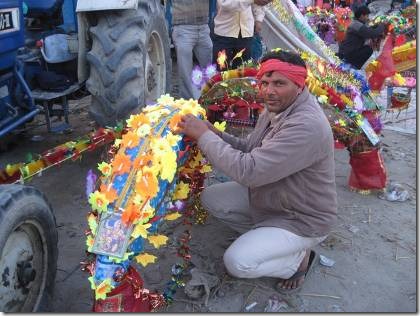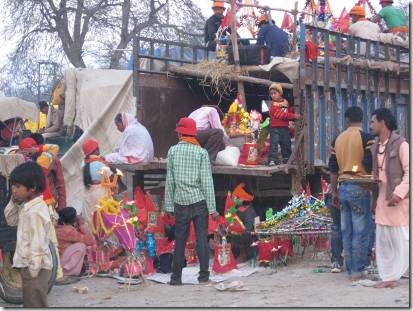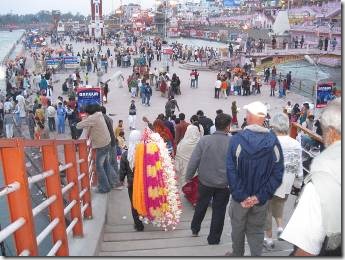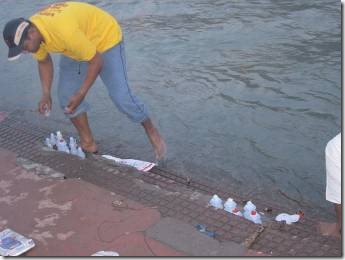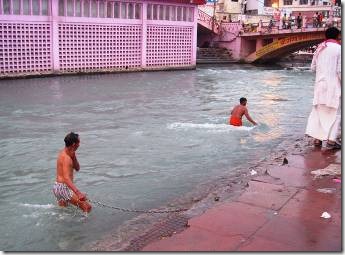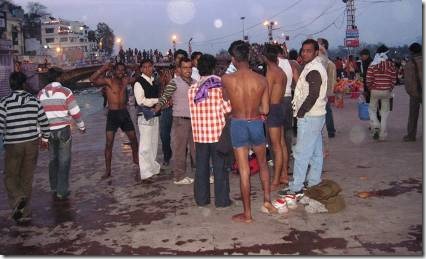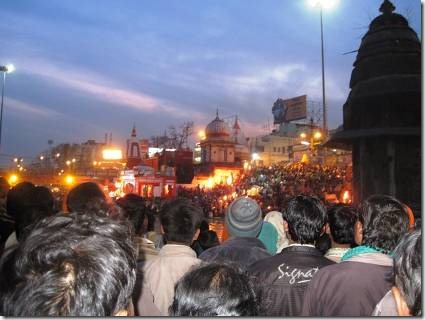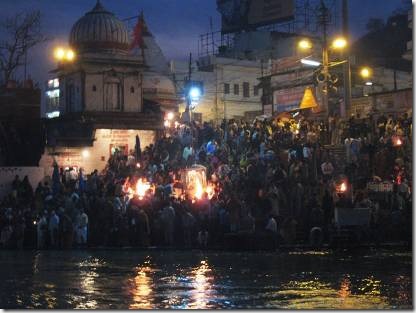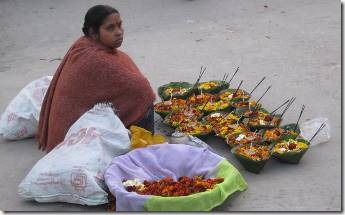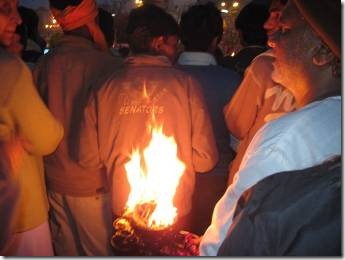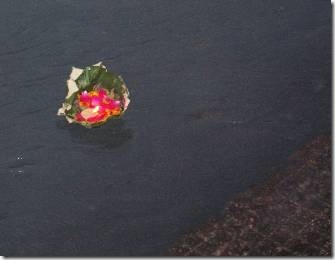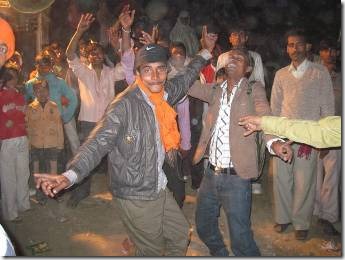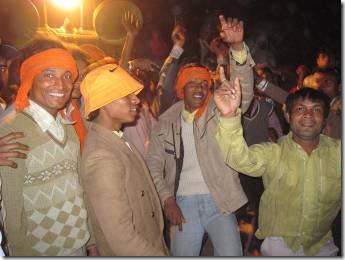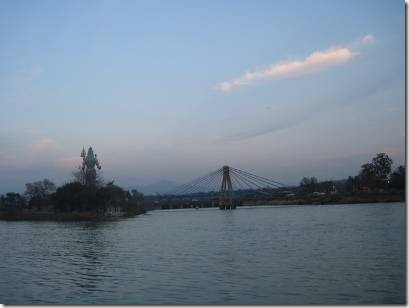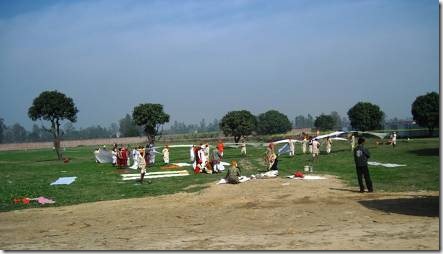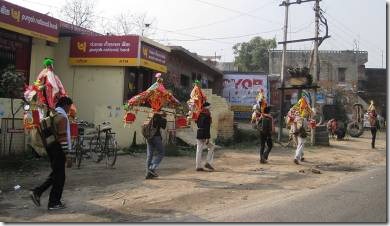Randal opted out, but Linda, Michael and I went off to watch the nightly ceremony along the Ganges in Haridwar. Sandeep told us that twice each year, villagers come to Haridwar to collect water to “walk” back to their villages. Some of the water is for the local temple and some of it is for the villager’s home and family. Luckily our visit coincided with one of the semi-annual events. It really was quite fun and the locals made us feel welcome, posing for our photos, posing with us for photos, and taking photos of us. Even here in Cochin people ask if I will pose with them for photos!
Ruth, Michael and Sandeep: Linda is taking the photo.
I spent a good deal of time with a red dot on my forehead.
Making the carriers for the holy water.
Many walkers opt to carry the Ganges water on these brightly decorated carriers. Once they are finished and the journey is started, they cannot touch the ground. And no one can walk under them.
These men were leaving Haridwar carrying the “kawad” of Ganges water.
Truck beds become living quarters for those who come to Haridwar either to bathe or to collect the water for their village. The next day when I described it to Randal I used the word sleeping bags and Sandeep emphatically told us that no one had sleeping bags. They just had blankets to wrap up in; sleeping bags would be too costly.
Pulling the wagon with a tractor.
These wagons coming from the villages and are one reason the traffic goes only 30 kilometers per hour.
Working on the kawads.
The men not only posed, but asked to have their photo taken. They also wanted us to pose with them for their photos. We were the stars of the show.
It was very much a festival atmosphere for the whole family.
We walked from the camping area to the part of the Ganges where people were bathing and where the evening ceremony took place.
Collecting Ganga water.
The water moves very swiftly so chains are provided for bathers to hold on to.
These bathers wanted their photo taken too.
No women seemed to be bathing and everywhere were much shyer about having their photos taken.
Then it was time for the evening ceremony…
“During a visit to the holy cities of Varanasi and Rishikesh/Haridwar, make time to partake of the most popular ceremony in Hindusim, Arti. Performed daily, several times throughout, Arti is a greeting ceremony offered to the murti and also gurus, holy people, and other representations of the divine.
Arti is often called “the ceremony of lights” but usually involves offering more than just a lamp.
The priest or worshiper offers various auspicious articles by moving them in clockwise circles before the deity. At the same time he or she rings a small hand bell, while meditating on the forms of the deity.
During the entire ceremony, which normally lasts from five to thirty minutes, the worshipper offers incense, a flower, water, a five-wick lamp, a lamp with camphor and other items. The ceremony is often announced and concluded by the blowing of a conch-shell.
During the ceremony the offered lamp is passed around the congregation; members pass their fingers over the flame and reverently touch them to their foreheads. The offered flowers are also passed around worshippers and the water is sprinkled over their heads.
Arti is usually accompanied by singing (bhajan/kirtan) and out of respect worshippers usually stand for the entire ceremony.
Source – The Heart of Hinduism
Morning Arti begins before sun up, which means you’ll be crawling out of bed in the 5 o’clock hour to reach the temple in time. Tourists aren’t a common sight at this time but of course welcome.
Evening Arti is when you’ll encounter the most tourists. Varanasi has an amazing display right on the Ganges. To enhance your participation and/or observation, find a boat-for-hire down river from Dasaswamedh Ghat. Row into the area of this main ghat where the ceremony takes place. You won’t be alone as many other tourists and some locals will be gliding up to view the Arti. Along the way you’ll be approached by vendors on their own boat selling ghee candles tucked into a small tray-like bowl. The transaction is very quick and simple. Light the wick, make a prayer and set the candle onto the river’s surface. As you reach Dasaswamedh Ghat, you’ll notice a steady stream of candles passing you by.
In Haridwar, the Arti also is performed on the Ganges. And just like Varanasi, ghee candles are lit and sent off into the current. The river runs much stronger in the Arti area, adding to the cornucopia of sights and sounds already on display. The ceremony can be viewed on either side of the river here with massive crowds all vying for the best position.
At Rishikesh, once again the ceremony can be found on the riverbanks of the Ganges. Ghat steps lead into the water allowing followers pristine access to launch their candles. The crowd here is younger and not as subdued as one would wish them to be. Loud dancing and over-the-top chanting comes across in a mocking fashion when played against the spiritual leaders’ rendition of events.” (Rishikesh was really quite “Yuppie/Touristy” so I’m not surprised to read that.)
http://www.fullstopindia.com/2010/01/must-see-arti-ceremony/
Because we had spent so much time visiting folks and posing for photos at the camping area, we arrived at the ceremony late and were several rows back so could not see very well. There were some prayers and singing which was quite lovely.
When the evening ceremony was over, I could get close enough to the river for a photo.
People bought these flower petals in a banana leaf to float along the river.
A man walked through the crowd with this fire and people sort of held their hands over it for a few seconds and perhaps lit the candle in the center of their flower petal container.
Floating down the Ganga.
After the ceremony people returned to the camping area where men started dancing.
Take my photo! Take my photo!!
Shiva and the new bridge across the Ganges
Walkers stopping to camp along the way.
Many roadside restaurants feed the walkers for free and give them places to rest. Some walkers rest during the day and walk at night. It would certainly be cooler and there would be less traffic and dust along the road.
Walkers along the side of the road.

